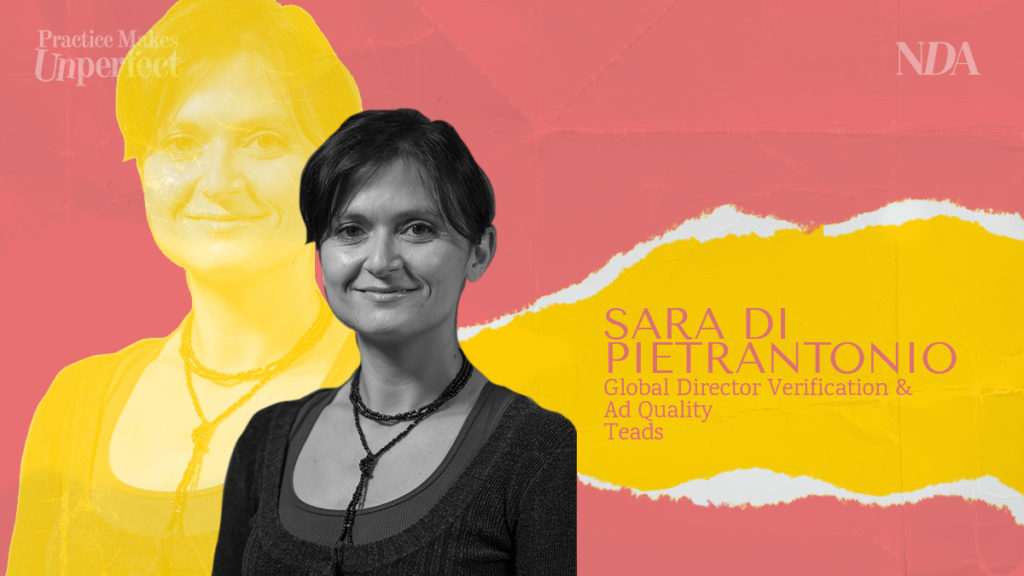By Sara Di Pietrantonio, Global Director Verification and Ad Quality at Teads
These articles have been written by the latest cohort of the Practice Makes UnPerfect programme – a course that helps women find and finesse their public voices.
Imagine starting a new job in an industry you have little experience in. New processes, new clients, new colleagues… Now, do the same, but in a foreign language.
That was me seven years ago, when I moved from Rome to London to work in ad tech. Sure, I had studied English and lived abroad before, but the first few months in London were tough: I probably didn’t compute 50% of what my English colleagues were talking about at the office – let alone at the pub – and I was basically scared of being fired without even understanding they were telling me I was fired.
In the last few years, the subject of diversity and inclusion has started to receive the attention it deserves. While it’s becoming more common for global companies to have D&I policies related to race, sexual orientation, disability… linguistic diversity is often overlooked. And yet, plenty of academic research shows that languages are an inherent attribute of our identity – not as easily changed by just a few language classes – and that the way we speak – including accent – is often the reason for stereotypes and stigma.
According to an article published in 2018 on the Journal of Applied Behavioural Science “language diversity can elicit more subtle forms of discrimination at work compared with the other diversity attributes, given that objective challenges in communication are used as appropriate reasons for hiring and promotion decisions that penalize nonnative speakers”.
The same article reports a recent study showing that nonnative speakers are significantly less likely to receive promotions or funding after delivering the exact same scripted speech as their native counterparts.
The fact that English is used by most companies as the “lingua franca” of international communication gives English native speakers a privilege they are usually oblivious to.
Having a multilingual workforce is a competitive advantage for businesses, and it should be encouraged, but, if they truly care about giving each employee – quite literally – a voice, international companies should start doing a better job at addressing the objective challenges that varying levels of fluency in the common working language pose for organisational dynamics and individuals with different linguistic backgrounds.
Speaking to each other can be very tiring for both English native and nonnative speakers, due to the extra cognitive effort needed to understand each other. They also experience negative emotions like frustration, embarrassment, shame and anxiety. To avoid this, they tend to limit interactions, which can result in duplicated work, poor knowledge-sharing and ultimately missed business opportunities.
On the one hand, native speakers are often unsure of how to handle misunderstandings sensitively. On the other hand, nonnative speakers feel constantly evaluated and afraid of being perceived as less competent in their subject matter due to how well they speak English.
Negative stereotypes linked to foreign accents can easily lead to the conclusion that nonnative speakers should not be hired, as they are the cause of communication issues and hinder organisational performance, but as the sociolinguist, Ingrid Piller notes: “[…] dominant speakers of the dominant language oftentimes opt-out of sharing the communicative burden in interactions with subordinates speakers of subordinate varieties. Instead, they place the responsibility for ensuring communicative success exclusively on the shoulders of subordinated speakers, who are thus faced with a double handicap: despite having fewer standard language resources at their disposal, the communicative challenges they face are greater as dominant speakers often opt out of cooperating”.
According to Anne-Marie Pham, executive director of the Canadian Centre for Diversity and Inclusion (CCDI), promoting linguistic diversity within a business not only promotes workplace cohesion but is also important to rooting out negative cultural biases or exclusionary tendencies.
That said, for companies eager to integrate linguistic diversity in their D&I policy it’s hard to know where to begin. In fact, there is a broad range of possible initiatives aimed at mitigating language-based bias, strengthening collaboration between native and nonnative speakers and ultimately fostering an organisational culture that celebrates language diversity.
To set the tone, companies could start by explicitly endorsing linguistic diversity in their D&I policy.
Top leaders could show commitment by learning a foreign language and actively using it with employees where relevant. Or they could hire interpreters to allow speakers to use their own language at international company events.
Providing English language classes to nonnative speakers is all good and well, but native speakers should also be trained on how to speak English in a way that is easier to understand for a global audience: try and limit slang, local cultural references or idioms (just say “the deal is not done yet” and not “It ain’t over till the fat lady sings”). Using visual support and sharing written notes in advance of meetings is also helpful. And please, please, please: if asked to repeat, speak more slowly, not louder!
Similarly, every employee could be trained on the pronunciation of frequently used English words in a variety of accents, and to deconstruct the hidden biases they may have related to “prestigious” varieties of English. Perceiving their accent as something to be proud of would make nonnative speakers feel more confident when interacting in English, and not hold back asking questions or sharing their opinion.
Companies could also offer safe spaces for employees to vent their language-related concerns, like language diversity days, with role-taking simulations to foster empathy and workshops on how to deal with language-related negative emotion and misunderstandings.
Some more fun and lighthearted initiatives could be lunchtime language exchange groups or “words of the week”, in which staff who speak a different language teach a few new words to their colleagues.
Language diversity in the workplace is the present and the future, and responsible companies and leaders should start taking that aspect of their employees’ identity into higher consideration when designing their D&I policies, to create an environment that allows both native and nonnative speakers of the dominant language to thrive and feel included.
As for me, I still don’t totally understand my English colleagues at the pub, but I became familiar enough with British culture to realise they probably don’t understand each other either, but they are too polite to say it.









